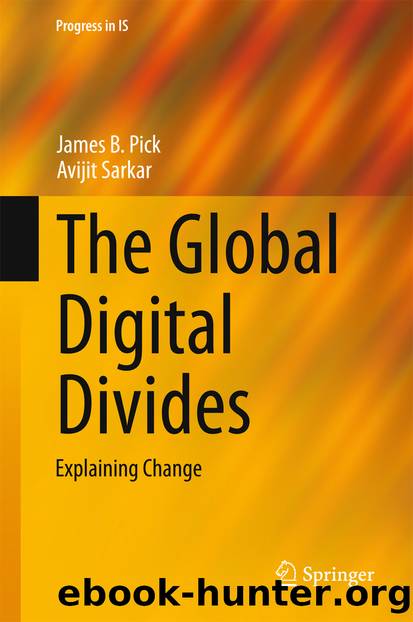The Global Digital Divides by James B. Pick & Avijit Sarkar

Author:James B. Pick & Avijit Sarkar
Language: eng
Format: epub
Publisher: Springer Berlin Heidelberg, Berlin, Heidelberg
6.9 Conclusions
Telecommunications and ICT use in India have come a long way since economic liberalization of the early 1990s. Today, India has the second largest base of mobile cellular subscribers and third largest base of internet subscribers worldwide. This has been made possible through a combination of technological change, regulatory initiatives, and key changes in the governance of the telecom sector in India. However challenging problems with ICT penetration persist and India’s ICT penetration rates especially in internet and broadband lag significantly behind rates of China and other BRICS nations . Compounding factors are infrastructural, such as unreliable electricity, and also regulatory, such as complexities with land acquisition and right of way.
Despite these obstacles, a handful of Indian states have made significant progress in ICT adoption and utilization. The nation’s capital Delhi, a state and megacity, leads in terms of teledensity, and internet and broadband subscribers per capita; in fact, our analysis reveals Delhi to constitute a singularly high ICT use cluster, followed by Himachal Pradesh and Punjab, both approximately 400 km from Delhi, and the southern Indian states of Kerala and Tamil Nadu. At the other end of the spectrum are states in central, northeast, and eastern India, Bihar, Uttar Pradesh, and Madhya Pradesh that are largely rural, and also India’s northeast. Our confirmatory analysis has revealed that key correlates of ICT utilization in India are (a) registered newspapers and periodicals, represented in our conceptual model of ICT utilization under the categories of societal openness and innovation, and (b) educational attributes . This chapter’s finding about societal openness is consistent with similar findings for Japan and the United States. When the high technology outlier state of Delhi is excluded, confirmatory analysis reveals the association of a key infrastructural variable, electrical capacity , with internet and landline phone subscribers. Case studies of ICT adoption in India, especially rural areas have identified the lack of reliable power supply as a key impediment for internet and broadband penetration. Another interesting finding of this chapter is the association of social capital, represented in this study by cooperative societies with internet and landline, when Delhi is excluded. This finding is consistent with the strong association of social capital with several ICTs, notably internet and broadband in the US. Cooperative societies in India, as exemplified by the Warana case study in rural Maharashtra provide a forum to members of a community with similar interests, often economic, to interact socially, influence peers, and exchange information. From a development standpoint, the local context is important to consider in endeavors to bridge the digital divide, as exemplified in rural parts of India.
In August 2014, the Union Cabinet of India sanctioned Rupees 113,000 crores (US$18.83 billion approx.) for “Digital India”, an initiative to build a nationwide fiber optic network that connects village panchayats across the country in three years (Press Information Bureau Government of India 2014; Forbes 2014). The vision for this initiative includes digital infrastructure as a utility to every citizen, governance and services on demand, and digital empowerment of citizens.
Download
This site does not store any files on its server. We only index and link to content provided by other sites. Please contact the content providers to delete copyright contents if any and email us, we'll remove relevant links or contents immediately.
Life 3.0: Being Human in the Age of Artificial Intelligence by Tegmark Max(5474)
The Sports Rules Book by Human Kinetics(4292)
The Age of Surveillance Capitalism by Shoshana Zuboff(4209)
ACT Math For Dummies by Zegarelli Mark(3994)
Unlabel: Selling You Without Selling Out by Marc Ecko(3588)
Blood, Sweat, and Pixels by Jason Schreier(3565)
Hidden Persuasion: 33 psychological influence techniques in advertising by Marc Andrews & Matthijs van Leeuwen & Rick van Baaren(3472)
The Pixar Touch by David A. Price(3362)
Bad Pharma by Ben Goldacre(3355)
Urban Outlaw by Magnus Walker(3339)
Project Animal Farm: An Accidental Journey into the Secret World of Farming and the Truth About Our Food by Sonia Faruqi(3177)
Kitchen confidential by Anthony Bourdain(3009)
Brotopia by Emily Chang(3000)
Slugfest by Reed Tucker(2939)
The Content Trap by Bharat Anand(2860)
The Airbnb Story by Leigh Gallagher(2798)
Coffee for One by KJ Fallon(2565)
Smuggler's Cove: Exotic Cocktails, Rum, and the Cult of Tiki by Martin Cate & Rebecca Cate(2471)
Beer is proof God loves us by Charles W. Bamforth(2370)
